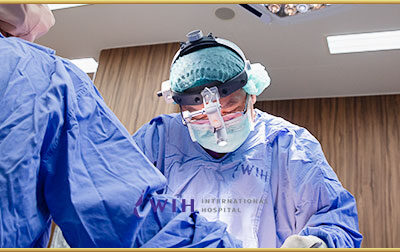
Correcting Pixie Ear at WIH Hospital
A pixie ear deformity occurs when the earlobe is unnaturally stretched downward and appears “stuck” to the cheek, often after a facelift surgery. At WIH International Hospital in Bangkok, our board-certified surgeons specialize in correcting pixie ear using advanced revision techniques to restore a natural, youthful earlobe contour with lasting results.
Pixie Ear Deformity
A pixie ear is a specific earlobe deformity where the earlobe appears unnaturally pulled downward and attached tightly to the side of the face. Unlike a natural, free-hanging earlobe, the pixie ear lacks the usual contour and looks “stuck” to the cheek. This condition is most commonly seen after facelift surgery (rhytidectomy) but may also result from trauma, poor healing, or congenital factors.
What Does a Pixie Ear Look Like?
The physical characteristics of a pixie ear are often quite distinct:
The earlobe is stretched and appears long or thin.
The natural space between the earlobe and the jawline is diminished or completely gone.
The earlobe seems to merge with the cheek, lacking a clear separation.
The shape can resemble the pointed ears often associated with fantasy characters, which gives the deformity its name. This appearance can make patients feel their results from a facelift look unnatural or “pulled,” leading them to seek a solution.
Causes of Pixie Ear Deformity
While pixie ear can be congenital (present from birth), it is most frequently a result of a previous plastic surgery procedure. The main causes include:
Facelift Surgery (Rhytidectomy):
This is the most common cause. When a surgeon applies too much tension to the skin flaps during a facelift, especially near the earlobe attachment point, it can pull the earlobe downward.
Incision Placement and Scarring:
Poor incision placement or excessive scarring and tissue contracture during the healing process can also distort the earlobe’s natural position.
Why Do Patients Seek Correction?
Although a pixie ear is not a medical problem, its cosmetic appearance can be a source of significant distress. Patients often seek correction to:
Restore a Natural Look: A well-contoured, free-hanging earlobe is considered a hallmark of a natural and youthful appearance.
Address Emotional & Social Anxiety: The “pulled” look can be a constant reminder of surgery, causing patients to feel self-conscious and avoid hairstyles that expose their ears.
Improve Facial Harmony: Correcting the earlobe restores balance and symmetry to the face, enhancing the overall aesthetic outcome of their facial rejuvenation.
How Can a Pixie Ear Be Fixed?
The good news is that a pixie ear can be effectively corrected. The procedure is typically a minor surgical revision performed under local anesthesia in our hospital. In more severe cases or if there is sufficient facial laxity, it may be combined with a full revision facelift.
Step-by-Step Surgical Technique
- Careful Evaluation: Our surgeon first assesses the degree of deformity and the amount of skin tension to determine the best approach.
- Releasing the Tether: A small incision is made to release the scar tissue and tethered skin that are pulling the earlobe down.
- Reshaping and Repositioning: The earlobe is then meticulously reshaped and repositioned to a more natural, higher position.
-
Securing the New Contour: The earlobe is secured to the skin with sutures to prevent future downward pull, creating a soft, natural contour.
- Inconspicuous Closure: The incision is strategically placed to hide the resulting scar. In many cases, the scar is placed in the natural crease behind the earlobe, making it barely noticeable.
Recovery After Earlobe Repair
The recovery process for pixie ear repair is typically quick and comfortable:
Initial Discomfort: Any early soreness is well-controlled with oral pain medication.
Swelling and Bruising: These side effects are minimal and typically subside within 3 to 5 days.
Suture Removal: Sutures are usually removed within 7 days.
Return to Activity: Patients can often return to non-strenuous work the following day and resume full activity in 2 to 3 weeks.
📌 Pros and Cons of Elf Ear (Pixie Ear) Surgery
Like any cosmetic procedure, pixie ear (elf ear) correction surgery comes with both benefits and considerations. Understanding these helps patients make informed decisions.
✅ Pros
- Restores natural appearance: Creates a free-hanging, youthful earlobe contour.
- Boosts confidence: Eliminates the “pulled” or “stuck” look that causes self-consciousness.
- Minimally invasive: Often performed under local anesthesia in a clinic setting.
- Quick recovery: Most patients return to daily activities within 1–2 days.
- Customizable correction: Can be done as a standalone procedure or during a revision facelift.
⚠️ Cons
- Small scar risk: A discreet vertical scar may remain under the earlobe.
- Mild swelling or bruising: Usually resolves within a week, but temporary.
- Not non-surgical: Correction always requires a surgical approach.
For many individuals, the emotional and aesthetic benefits of elf ear correction far outweigh the minimal risks and downtime. By choosing an experienced, board-certified surgeon, you can achieve a natural ear shape, improved facial balance, and a significant boost in confidence.
FAQ
No, surgical intervention is required to release the tethered tissue and restore the earlobe’s natural shape.
Yes, the results are permanent. However, if you undergo future facelift surgery, it is crucial to discuss techniques to prevent the deformity from recurring.
The most significant difference is the loss of the free-hanging contour. A natural earlobe has a visible space between it and the face, whereas a pixie ear is attached directly to the cheek.
Pixie ear repair is typically performed using local anesthesia as an office-based procedure, meaning you are awake but the area is completely numb.

